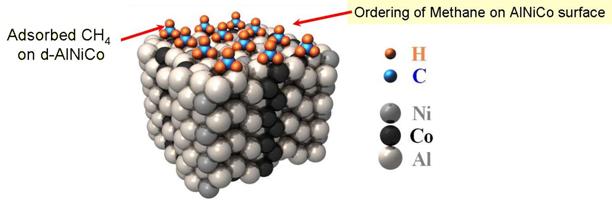

45814-G5
Is Superlubrication Possible in Engines? Characterization of the Adsorption of Hydrocarbons on Quasicrystal Surfaces
Research
Friction between incommensurate surfaces can be vanishingly small (superlubricity). The aperiodic structures of quasicrystals make their surfaces ideal candidates for superlubricity. Indeed, the special frictional properties of quasicrystals have been confirmed in a series of experiments using atomic force microscopy on single grain quasicrystals. Although its origin is not yet completely understood, the common belief is that poor coupling of phonons at the interfaces may play a major role. Even before single crystal experiments, however, experiments on quasicrystal coatings indicated that oxidized poly-quasicrystalline coatings exhibit low friction behavior. The first measurements of the low friction of quasicrystalline coatings led to their subsequent development in applications involving moving machine parts and non-stick cookware. In most applications involving machine parts, additional lubricant would be needed to address the frictional contributions of grain boundaries and asperities. Since the low friction of quasicrystals is clearly related to their structure, the interaction of the lubricant with the quasicrystal and the structure of the lubricating film is particularly important. Although, studies of metal and rare gas adsorption on quasicrystals have indicated that both periodic and aperiodic structures can occur in thin films, little is known about the interaction of hydrocarbons with quasicrystal surfaces.
In this sponsored research, we have addressed the fundamental issues that affect the growth and structural properties of gases on a quasicrystal surface. We have devised theoretical studies of the adsorption and growth of rare gases and hydrocarbons on such system.
[A] By parameterizing through the Grand Canonical Monte Carlo method (GCMC) the evolution of topological order in Xe Films on decagonal Al-Ni-Co surface we have discovered a 5- to 6-fold first order symmetry transition, which explains previous experimental results.
[B] We have constructed a phenomenological rule predicting the existence of this transition as function of size mismatch between the contaminant atoms (lubricants) and the surface. Occurrence of the transition increases friction.
[C] By calculating “Embedded Atom Method” interaction between simple hydrocarbons and the decagonal Al-Ni-Co surfaces, we have found that the transition, present for benzene and absent for methane, corroborates the phenomenological rule based on adsorbate-substrate size mismatch.
Table. Summary of adsorbed noble gases and selected hydrocarbons on the QC that undergo a first-order fivefold to sixfold structural transition and those that do not. The size mismatch is defined as dm ≡ (k · σgg - λr)/λr , where k = 0.944 is the distance between rows in a close-packed plane of a bulk LJ gas, λr is the characteristic spacing of the QC, determined from the momentum transfer analysis of LEED patterns. We have transition when dm>0.
Impact of the research Nothing was known about hydrocarbons adsorbing
on QC before this research proposal. Our work has revealed novel
understanding of the roles of the adsorbate-size and
surface-corrugation on the topological order of the adsorbed film. When the 5-
to 6-fold transition is missing, the monolayer does not form a periodic
structure and the adsorbed surface does not change the commensurability of the
system. The quasicrystalline film of methane that we predoct
indicates the potential use of quasicrystals as low-friction coatings in
environments where methane is present. Even though longer alkanes
form a periodic close-packed structures, the commensurability occurs only when
their films are exactly aligned, suggesting that lubricity might still be
enhanced with quasicrystalline coatings. Theoretically,
an internal combustion engine with pistons and cylinders coated with Al-Ni-Co
could work without the help of a lubricant if burning methane as combustible at
medium temperature. Our work is currently submitted to Phys. Review
Letters.
Impact of the PI career Superlubrication and surface science is one the research
topics of the PI's group. The collaboration with Dr. Diehl at Broad Impact on the student education Wahyu Setywan
was the graduate student working on this project. This research represents a
substantial part of his Ph.D. dissertation which was defended in 2008. During
his research, Setyawan has learned thermodynamics, surface science, and computational
modeling of adsorption. Our Embedded Atom Method potentials for Al-Ni-Co have
been shared with other scientists working in adsorption and surface science.

